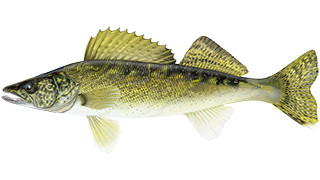Non-urgent government operations are closed December 24 to January 1, reopening January 2. View available services during this period.

The Walleye (lakes) Fish Sustainability Index (FSI) summarizes scientific and local knowledge to assess the status of walleye in lakes in Alberta. Alberta walleye populations in rivers will be assessed separately.
Walleye FSI Maps
Adult density (current and historic)
The following maps are available in the Open Government Publications Portal:
- Walleye fish sustainability index: current adult density
- Walleye fish sustainability index: historic adult density
Access the following record in the portal to review the maps:
Habitat and overharvest protection needs
The following maps are available in the Open Government Publications Portal:
- Walleye fish sustainability index: habitat protection need
- Walleye fish sustainability index: overharvest protection need
Access the following record in the portal to review the maps:
Please note that data reliability is not currently displayed in these figures.
Walleye FSI spatial layers can be viewed on our interactive web mapping platform.
Walleye population status
Walleye in Alberta are located near the northern edge of this species' range, and compared to southern populations, growth rates are slower, maturity is later and consequently the fisheries are less productive. Historically, walleye were likely in only about half of Alberta's fish-bearing lakes. Many Alberta lakes are naturally limited by low oxygen, small size, or high salinity and would not have supported walleye.
Historically, about 2/3 of walleye populations were considered abundant. After the collapses of the 1970s and 80s, today almost 1/4 of populations have recovered.
- Historical status (adult density): 68%, 125/185 of populations at low to moderate risk.
- Current status (adult density): 29%, 53/185 of populations at low to moderate risk.
For further information, see:
Threats to sustainability
The main threats to sustainability of walleye in lakes were noted as:
- Nutrient runoff from development (mainly agriculture and urbanization, but also forestry and oil and gas development) into the surrounding watershed has resulted in algae blooms and declining oxygen levels, which has increased the frequency of fish summer and winter kills in lakes.
- Overharvest (including hooking mortality and poaching) continues to threaten walleye sustainability, although conservation-based regulations have resulted in the recovery of populations at numerous lakes.
Next steps
- Continue standardized monitoring of fish in lakes using Fall Index Netting (FIN) protocols.
- Consultation with First Nations, anglers, and Alberta's public to determine practical and desired state of the fisheries.
- Recover collapsed (high risk) walleye fisheries to more sustainable levels.
- Ensure watershed planning councils understand and act to conserve clean water and healthy fisheries.
- Implement simple and effective sport fishing regulations, with goals of providing more sport fishing opportunities and recovering fisheries.